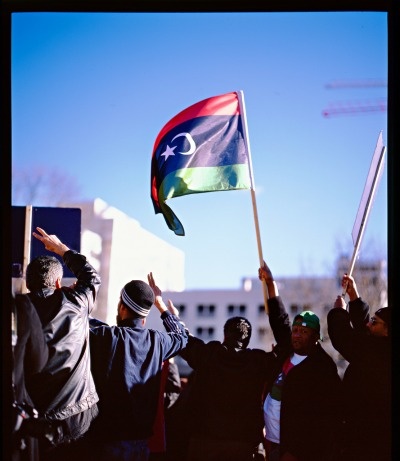UPDATE: Libyan Oil Production, Outage, Exports, Customers

As fighting continues across Libya, the oil industry is trying to assess the output lost from Africa's third-largest producer. Most estimates suggest around half of the country's 1.6 million barrels per day (bpd) of oil capacity is out of action. Libya's top oil official has estimated oil output has fallen to 700,000-750,000 barrels per day (bpd). Below are details on Libya's oil production, estimates of lost output, its exports and customers:
Production
OPEC member Libya is the 17th largest oil producer in the world, third-largest producer in Africa and holds the continent's largest crude oil reserves. It normally pumps around 1.6 million bpd, 85% of which is exported to Europe and its output is equivalent to about 2% of global oil consumption.
Lost Output
Estimates of lost Libyan production have varied widely, from 100,000 to 1.2 million bpd. The International Energy Agency has said about half of Libya's output has been shut.
Shokri Ghanem, head of Libya's National Oil Corp (NOC) and the country's top oil official under Muammar Gaddafi, said on Wednesday output had dropped to 700,000-750,000 bpd after the flight of most of the foreign workers who make up 10% of the Libyan energy industry's workforce.
An oil facility at Zueitina, south of the rebel-held city of Benghazi, has been damaged and was on fire on Friday, Al Jazeera reported, showing a video of smoke rising from an oil plant. No other damage to Libya's oil infrastructure has yet been reported but the risk of long-term damage is rising.
Libya's battle lines are shifting daily, with rebels in tenuous control of the east and the fighting is increasingly taking place near oil industry infrastructure on the coast. Fighting has taken place around the oil terminal and export hub town of Brega an oil 800 km (500 miles) east of Tripoli. The town is currently in rebel hands.
Exports
Libya is a net exporter of crude oil and normally sells around 1.3 million bpd into world markets. It has domestic consumption estimated of around 270,000 bpd. At least 2.4 million barrels of crude was exported earlier this week in four tankers but others were cancelled as supply to terminals dwindled.
At least one tanker left a Libyan terminal empty on Thursday and only a small number of other tankers were waiting to enter Libyan ports.
Oilfields
Most of Libya's oilfields are located in and around the Sirte Basin, which contains around 80% of its proven reserves. Oil had reportedly stopped flowing at the Nafoora oilfield in the Sirte basin, according to Al Jazeera, although few details were available.
Other key areas include the Ghadames Basin and Cyrenaica Basin. Oil production from the isolated Murzuq oil field in the desert in the south of the country continues as normal, a spokesman for Spanish operator Repsol said last week.
Ports
Libyan oil port activity has slowed dramatically, but most ports are open with tankers leaving and waiting to enter. Priority has been given to passenger vessels evacuating civilians and communications with harbor officials and agents has been extremely difficult, trade and shipping sources said.
Libya's oil port operations have been at a virtual standstill due to underproduction and bad weather. But at least two ports, Melittah and Zawiyah, have reopened. Es Sider, the largest oil port in Libya, and Tobruk continue to operate. London's marine insurance market has added Libya to a list of areas deemed high risk, increasing significantly the cost of sailing to the country's ports.
Libya exports various grades of light crude from six major terminals, five of which are located in the eastern part of the country, now mostly in rebel hands.
Following are the eastern terminals with loading volumes in January, provided by the IEA.
• Es Sider 447,000 bpd
• Marsa El Brega 51,000 bpd
• Ras Lanuf 195,000 bpd
• Tobruk 51,000 bpd
• Zueitina 214,000 bpd
• Zawiyah 199,000 bpd (January exports)
• other unspecified terminals 333,000 bpd
Sanctions
Western countries, the European Union and United Nations have all imposed sanctions on Libya and frozen government assets.The sanctions have not targeted oil exports but would be likely to affect the ability of the Gaddafi administration to collect payment for oil exports.
Customers
Europe is most affected by the loss of Libyan oil exports. About 32% of its oil goes to Italy, 14% to Germany, 10% to France and China and 5% to the United States. Libyan oil accounts for about 23% of Ireland's oil and about 22% of Italy's, according to the IEA. Around 13% goes east of the Suez Canal to Asia.
Buyers have said the shortage can be covered by alternative sources such as Nigeria and Azerbaijan, which produce similar light, low sulfur crude oils to Libyan oil.
Saudi Arabia is pumping around 9 million bpd and has spare capacity of around 3.5 million bpd, a senior Saudi source said on Monday. The kingdom has promised to fill any supply gap caused by the unrest in Libya although it produces heavier crude with higher sulfur content than Libya.
Libyan Oil Companies
Libya's oil industry is run by the state-owned NOC, which is responsible for exploration and production sharing agreements with international oil companies. Along with smaller subsidiaries, NOC accounts for around 50% of the country's oil output.
A unit of NOC, Agoco, has decided to operate separately until Gaddafi is overthrown and Tripoli is free of his rule, an official said.
Foreign Players
Major oil companies operating in Libya include:
• BP
• ConocoPhillips
• Eni
• ExxonMobil
• Hess Corp
• Marathon
• Occidental Petroleum
• OMV
• Repsol
• Shell
• Statoil
• Wintershall, a unit of BASF
Refineries, Refined Oil Products
The country has five domestic refineries with a combined capacity of 378,000 barrels a day:
• Azzawiya Oil Refining Co
• Sarir Refining
• Sirte Oil Co
• Tobruk Refining
• Ras Lanuf Oil & Gas Processing Co
The IEA said Libya last year imported about 80,000 bpd of refined oil products and exported about 100,000 barrels of oil products to OECD countries, mostly in Europe.
















